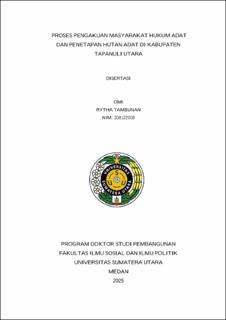| dc.contributor.advisor | Harahap, Hamdani | |
| dc.contributor.advisor | Subhilhar | |
| dc.contributor.advisor | Irfan | |
| dc.contributor.author | Tambunan, Rytha | |
| dc.date.accessioned | 2025-07-24T04:40:40Z | |
| dc.date.available | 2025-07-24T04:40:40Z | |
| dc.date.issued | 2025 | |
| dc.identifier.uri | https://repositori.usu.ac.id/handle/123456789/106982 | |
| dc.description.abstract | The process ofrecognizing customary law community and establishing customary forests involves coordination among the central government through the Ministry of Environment and Forestry/KLHK, regional governments, and customary law communities within their customary territories (wilayah ulayat). Constitutional Court Decision No. 35/PUU-X/2012 serves as the legal basis for customary community to claim their rights to manage customary forests.This research aims to explain the various processes of recognition of customary law communities and the establishment of customary forests among the Toba Batak community in North Tapanuli Regency following Constitutional Court DecisionNumber 35/PUU-IX/2012. It also explores how Batak Toba local wisdom coexists with state regulations and how various stakeholders and actor groups, each with their own interests, are involved. Legal pluralism provides an analytical lens to examine resolution of customary land dispute and the challenges faced by customary law community until the issuance of the decree recognizing customary forests by KLHK. This research uses a descriptive-qualitative approach using field observations, in-depth interviews, focus group discussions, and the collection of oral histories and research documents techniques. The data are analyzed continuously throughout the research process and are further examined to understand the coexistence between state regulations and customary laws. The research results show the coexistence of various state regulations with customary legal norms and institutions are used to resolve tenure-related disputes faced by customary law communities. Indigenous claims corporations that have occupied customary forests/customary territories as concessions. The Ministry of Environment and Forestry's policy is used to resolve disputes in the field, involving members of the Batak Toba customary community, who are bound in social structures through the "dalihan na tolu" genealogical clan and uphold their local wisdom. The legal resolution of customary forest claims in North Tapanuli is implemented through the identification, verification, and issuance of a Decree on Customary Forest Designation by the Ministry of Environment and Forestry, allowing management of customary forests within their customary territories. | en_US |
| dc.language.iso | id | en_US |
| dc.publisher | Universitas Sumatera Utara | en_US |
| dc.subject | Customary Law Communities | en_US |
| dc.subject | Customary Forests | en_US |
| dc.subject | Genealogical Clan Local Wisdom | en_US |
| dc.subject | Constitutional Court Decision No.35/PUU-X/2012 | en_US |
| dc.subject | Legal Pluralism | en_US |
| dc.title | Proses Pengakuan Masyarakat Hukum Adat dan Penetapan Hutan Adat di Kabupaten Tapanuli Utara | en_US |
| dc.title.alternative | The Process of Recognition of Indigenous Peoples and Determination of Customary Law in North Tapanuli Regency | en_US |
| dc.type | Thesis | en_US |
| dc.identifier.nim | NIM208122008 | |
| dc.identifier.nidn | NIDN0027026403 | |
| dc.identifier.nidn | NIDN0018076205 | |
| dc.identifier.nidn | NIDN0004116405 | |
| dc.identifier.kodeprodi | KODEPRODI95006#Studi Pembangunan | |
| dc.description.pages | 262 Pages | en_US |
| dc.description.type | Disertasi Doktor | en_US |
| dc.subject.sdgs | SDGs 10. Reduce Inequalities | en_US |


